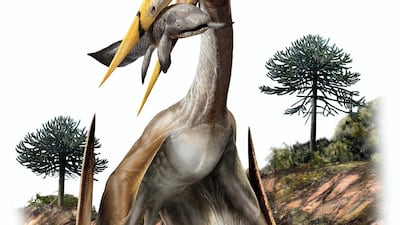One of mysteries of flight for a dinosaur-like reptile with a long neck and heavy head has been uncovered by palaeontologists.
The azhdarchid pterosaur was a giant reptile with a head that could measure 1.5 metres and a neck longer than a giraffe, a build that seemed ideal for keeping a creature on the ground.
But palaeontologists from the University of Portsmouth have worked out how highly evolved, lightweight vertebra helped the pterosaur to soar.
A CT scan of remains found in Morocco revealed a complex image of spoke-like structures – similar to those on a wheel – arranged in a helix around a central tube inside the vertebra, the team revealed in the journal iScience.
"It enabled the animal to have a very long neck without adding any extra weight. Indeed, it actually allows a weight reduction. The weight reduction of course did aid flight," Dave Martill, professor of palaeobiology at the University of Portsmouth told The National.

"It has been suggested that these large forms with long necks might have been flightless. We now know that they had found another way of reducing the mass of the skeleton, and it is doubtful if they were flightless," he added.
The intricate but lightweight design allowed the reptile to support its massive head without compromising flight.
"It is unlike anything seen previously in a vertebra of any animal," said Proif Martill.
"The neural tube is placed centrally within the vertebra, and is connected to the external wall via a number of thin rod-like trabeculae, radially arranged like the spokes of a bicycle wheel, and helically arranged along the length of the vertebra.
"They even cross over like the spokes of a bicycle wheel. Evolution shaped these creatures into awesome, breathtakingly efficient flyers."
Researchers initially intended to study the shape and movements of the neck, but the CT scan took their analysis in a new direction.
"These animals have ridiculously long necks, and in some species the fifth vertebra from the head is as long as the animal's body," said Cariad Williams, first author of the report.
"It makes a giraffe look perfectly normal. We wanted to know a bit about how this incredibly long neck functioned, as it seems to have very little mobility between each vertebra."
Analysis showed that as few as 50 of the 'spokes' in the pterosaur's neck could lead to a 90 per cent increase in resistance to buckling.
"What was utterly remarkable was that the internal structure was perfectly preserved – so too was the bone cell structure when we examined it under the microscope," Prof Martill said.
"As soon as we saw the intricate pattern of radial trabeculae we realised there was something special going on."
Pterosaurs first appeared in fossil records from the Triassic period, about 225 million years ago, but they disappeared at the end of the Cretaceous period, 66 million years ago, along with their dinosaur cousins.


